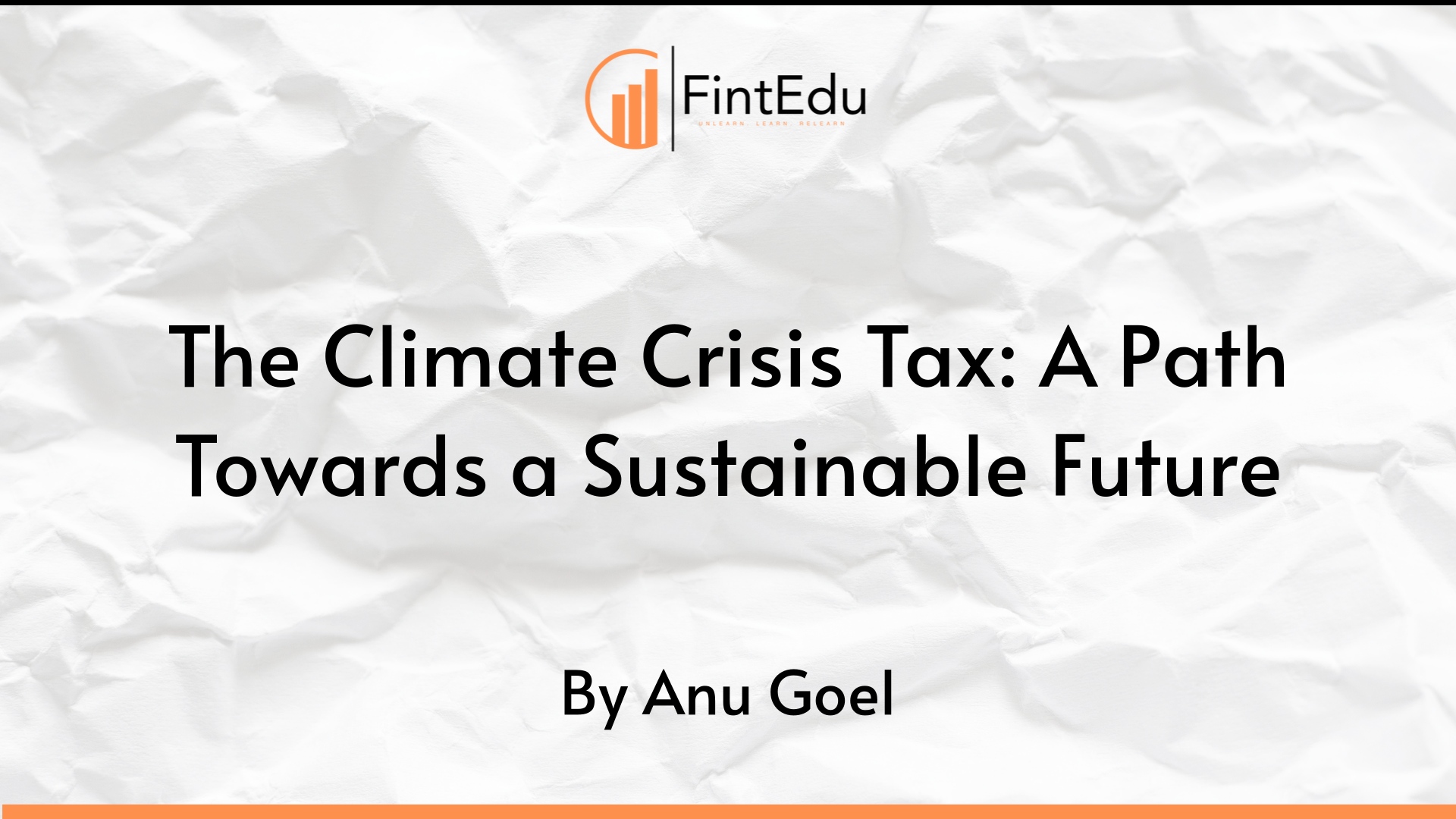LISTEN TO THIS ARTICLE
The Climate Crisis Tax, also known as a carbon tax or environmental tax, is a fiscal policy designed to reduce greenhouse gas emissions by taxing activities or products that contribute to climate change. At its core, this tax targets industries and individuals responsible for excessive carbon emissions, encouraging a shift to cleaner and more sustainable energy sources. The goal is to financially disincentivize activities that damage the environment, driving innovation in renewable energy and other green technologies.
The tax is structured to directly impose costs on carbon-emitting entities, thus integrating the environmental cost into the economic cost of production and consumption. The idea is that when these costs are reflected in the price of products and services, businesses and consumers will shift toward eco-friendly alternatives.
Why is There a Need to Impose a Climate Crisis Tax?
As the world grapples with increasing climate disasters—ranging from extreme weather events to rising sea levels—the need for decisive action has never been more urgent. According to the Intergovernmental Panel on Climate Change (IPCC), the window to mitigate catastrophic global warming is rapidly closing, making strong economic measures necessary. Here are key reasons why a Climate Crisis Tax is needed:
Curbing Greenhouse Gas Emissions: Carbon dioxide (CO2) and other greenhouse gases trap heat in the Earth’s atmosphere, leading to global warming. Imposing a tax on carbon-intensive industries incentivizes businesses to adopt cleaner practices, reducing overall emissions.
Encouraging Renewable Energy Use: By making carbon-heavy energy sources like coal, oil, and natural gas more expensive, a climate tax encourages a switch to renewable energy sources such as wind, solar, and hydropower. This shift is vital for transitioning to a low-carbon economy.
Funding Climate Adaptation Projects: Revenues generated from the tax can be used to fund public investments in green infrastructure, reforestation, and technology development to mitigate and adapt to climate impacts.
Creating a Fairer Playing Field: Fossil fuel companies often enjoy subsidies that keep the price of carbon-based energy artificially low. A climate tax corrects this imbalance by factoring in the environmental damage caused by carbon emissions.
Countries Implementing Climate Crisis Taxes
Several countries have already taken steps to impose climate-related taxes, each with varying degrees of success:
Sweden: One of the pioneers in carbon taxation, Sweden introduced its carbon tax in 1991. Today, Sweden has one of the highest carbon taxes in the world, at over $130 per ton of CO2. This has contributed to a significant reduction in emissions without stunting economic growth.
Canada: Implemented a national carbon pricing system in 2019, starting at $20 CAD per ton and increasing to $50 by 2022. Provinces are allowed to design their own systems, as long as they meet the federal benchmark. This has created a market-driven incentive for reducing emissions.
Germany: In 2021, Germany introduced its own carbon pricing model for the transportation and heating sectors, which aims to support its national climate goals of reducing emissions by 55% by 2030.
United Kingdom: The UK introduced a "Carbon Price Floor" in 2013, aimed at supplementing the EU Emissions Trading Scheme. The tax has been credited with driving the country’s sharp reduction in coal use.
South Korea: As part of its Green New Deal, South Korea has implemented a tax on greenhouse gas emissions, aiming to reduce reliance on fossil fuels and foster innovation in renewable energy.
Does the Climate Crisis Tax Make Sense?
The Climate Crisis Tax is both a practical and necessary tool for addressing the climate emergency. Here’s why:
Economic Efficiency: Traditional regulations often involve heavy bureaucratic oversight, making them cumbersome and expensive to enforce. A tax, however, provides a direct and transparent way to control emissions by influencing the price mechanism. By raising the cost of carbon emissions, it allows the market to find the most cost-effective ways to reduce pollution.
Driving Innovation: Taxes on emissions encourage businesses to develop greener alternatives and invest in cleaner technology. This can lead to economic growth in the green technology sector, creating jobs while also contributing to a sustainable future.
Polluter Pays Principle: Climate change is a global issue, but the burden of its costs is disproportionately borne by the poorest and most vulnerable communities. A Climate Crisis Tax shifts some of that burden onto those who are most responsible for pollution—high-emission industries—aligning with the “polluter pays” principle.
Behavioral Change: Taxing carbon emissions has the potential to change consumer behavior by making environmentally harmful goods and services more expensive. This encourages consumers to opt for greener choices, such as electric vehicles, energy-efficient appliances, or sustainably sourced products.
However, the success of such a tax is dependent on the details of its implementation. In countries where the cost of living is already high, a poorly designed tax could disproportionately affect low-income families by increasing energy bills and the cost of goods. For this reason, revenue from the tax should be used to mitigate these effects, perhaps by offering subsidies or tax breaks to vulnerable populations.
Challenges and Criticisms
While the Climate Crisis Tax is a promising solution, there are challenges to its implementation:
Political Resistance: Fossil fuel industries and their lobbyists often resist the imposition of such taxes, fearing that higher costs will lead to lower profits and job losses. This creates political barriers that are difficult to overcome.
Regressive Nature: Carbon taxes can be regressive, meaning they might disproportionately impact lower-income households that spend a higher percentage of their income on energy. Therefore, it’s critical to design these taxes in a way that avoids undue hardship for vulnerable populations.
Global Coordination: Climate change is a global problem, and carbon taxes in a single country may drive industries to relocate to nations with lax environmental laws. This underscores the need for global coordination, where countries adopt similar policies to avoid "carbon leakage."
Conclusion: A Step Toward a Sustainable Future
The Climate Crisis Tax offers a compelling tool to combat global warming by making polluters pay for the environmental damage they cause. While it’s not a silver bullet, when paired with other policy measures such as subsidies for renewable energy and international agreements, it can help shift economies towards sustainability.
In the long run, the tax not only supports climate goals but also promotes innovation, clean energy, and environmental justice. It is crucial, however, that governments consider the social implications of these taxes to ensure a fair and equitable transition to a low-carbon future.
As the climate crisis worsens, we cannot afford to delay—implementing a Climate Crisis Tax makes both environmental and economic sense.
Disclaimer: Content posted is for informational and knowledge sharing purposes only, and is not intended to be a substitute for professional advice related to tax, finance or accounting. The view/interpretation of the publisher is based on the available Law, guidelines and information. Each reader should take due professional care before you act after reading the contents of that article/post. No warranty whatsoever is made that any of the articles are accurate and is not intended to provide, and should not be relied on for tax or accounting advice.



